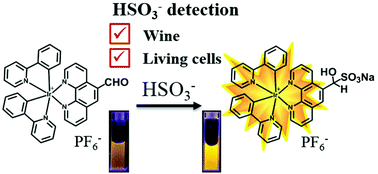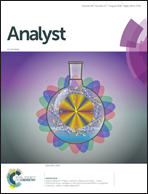Rapid “turn-on” photoluminescence detection of bisulfite in wines and living cells with a formyl bearing bis-cyclometalated Ir(iii) complex†
Abstract
A new photoluminescence (PL) probe based on a formyl bearing bis-cyclometalated Ir(III) complex, [Ir(ppy)2phen-CHO]+PF6− (1), is synthesized and applied to the selective detection of a bisulfite anion (HSO3−). Probe 1 is prepared using 2-phenylpyridine (ppy) as the C^N main ligand and 1,10-phenanthroline-5-carboxaldehyde (phen-CHO) as the N^N ancillary ligand. Probe 1 displayed excellent selective PL enhancement in response to HSO3− in acetic acid-sodium acetate buffer solution (pH = 5.0). The increase of PL signal is directly proportional to the concentration of HSO3− in the range of 2 μM to 45 μM with a detection limit of 0.9 μM using 50 μM probe 1 and in the range of 0.5 μM to 6 μM with a detection limit of 0.3 μM using 10 μM probe 1. More importantly, probe 1 can respond to HSO3− rapidly within 40 s. Furthermore, probe 1 was successfully applied to detect HSO3− in real white wines and the bioimaging of HSO3− in living cells. The superior properties of probe 1 make it of great potential use for studying the effects of HSO3− in other biosystems.



 Please wait while we load your content...
Please wait while we load your content...